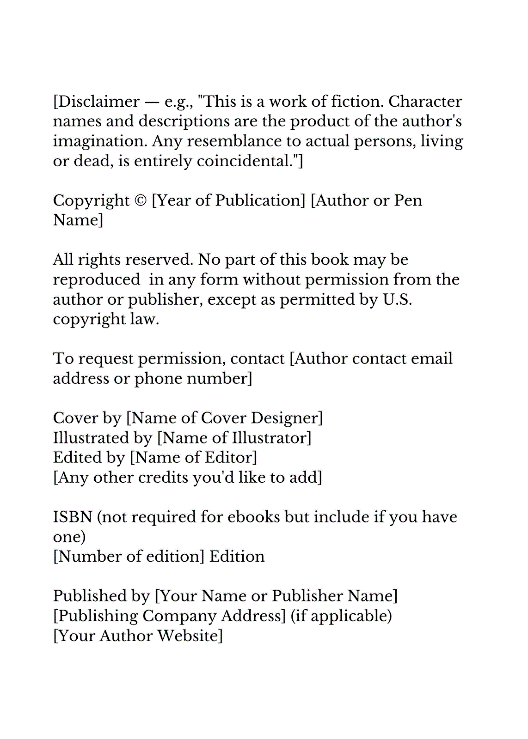- Published by

- 5-July-2023
E-Book Copyrights – What does it include:
A copyright page is a page that lets people know your eBook shouldn’t be treated as a public domain. It’s your way of telling people: I wrote this book and all rights are reserved. It also carries important information about the book and its publication. While this page might not add much value to the regular reader, it is going to protect your eBook from plagiarism. So if anyone did copy the content of your book without permission, you can easily sue them in a court of law.
Content Listed on an EBook’s Copyright Page
A book's copyright page holds essential information that every author should include. Here's a breakdown of what goes on a copyright page:

1. Copyright notice and year:
The copyright symbol ("©") should appear alongside the copyright owner's name, followed by the year. For example, "© 2017 by Jane Doe." If using a pen name, include it on the copyright page and register both names when filing with the U.S. Copyright Office.
2. Rights reserved notice:
State "All rights reserved" to indicate that the author retains exclusive rights to reproduce the book. Alternatively, provide a more detailed rights statement, specifying restrictions on reproduction and referring readers to the publisher for inquiries.
3. ISBN (International Standard Book Number):
An ISBN is essential for selling books, tracking editions, publishers, and regional codes. Purchase from Bowker for formats.
4. Library of Congress Control Number (LCCN):
Register with the Library of Congress for a free LCCN to establish book existence and library inclusion.
5. Disclaimer:
Fiction and nonfiction books often have disclaimers stating characters, plotlines, personal perspectives, and names changed for privacy.
6. Permissions notice:
If you use excerpts from other works, give proper credit on the copyright page to avoid copyright infringement. Specify the source of borrowed content, such as artwork, articles, or photographs.
7. Credits to editors, photographers, and illustrators:
Optional, but you can acknowledge the contributions of editors, photographers, and illustrators on the copyright page or include them in the acknowledgments section.
8. Country of printer/printing edition:
Include the country where the book was printed and indicate the printing edition, especially if it's the first edition. If using a print-on-demand (POD) printer, you can include their information here as well.
9. Publisher information:
Provide the name and address of the publisher. If self-publishing, you can use your personal information or create your own publishing company.
10. Author website:
Include your personal website on the copyright page to promote your work and direct readers to your other publications.
Parting Note:
A copyright page is essential for protecting your book, regardless of its genre or size. Without one, your book remains copyrighted, but proving ownership may be harder. It discourages plagiarism and announces ownership, similar to a "No Trespassing" sign. Stay proactive and happy writing!
It's not necessarily required to register your copyright, which is what people mean when they say "copyright your book," because your work is protected by intellectual property law as soon as it is written or saved (in every draught and edition).
Only the owner of the copyright in a work has the right to prepare or to authorize someone else to create, a new version of that work. Accordingly, you cannot claim copyright to another's work, no matter how much you change it unless you have the owner's consent


